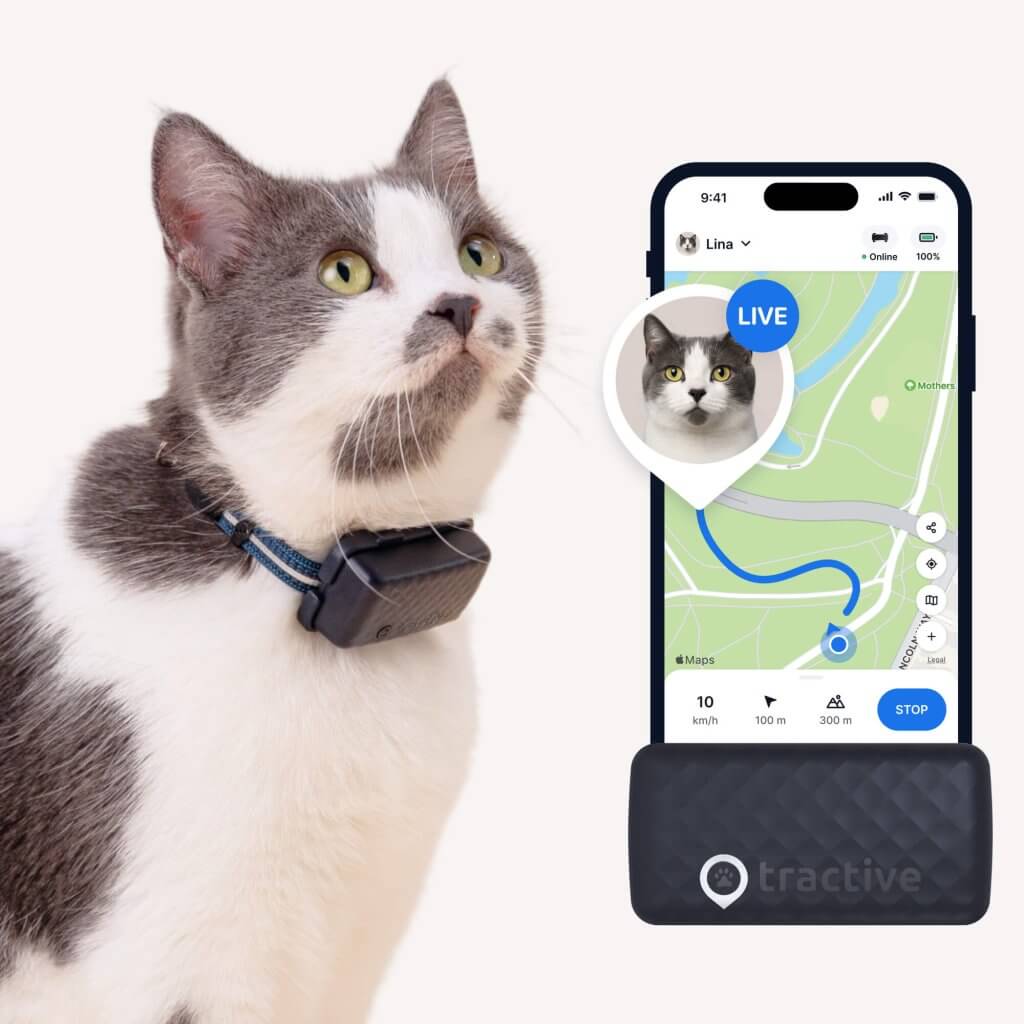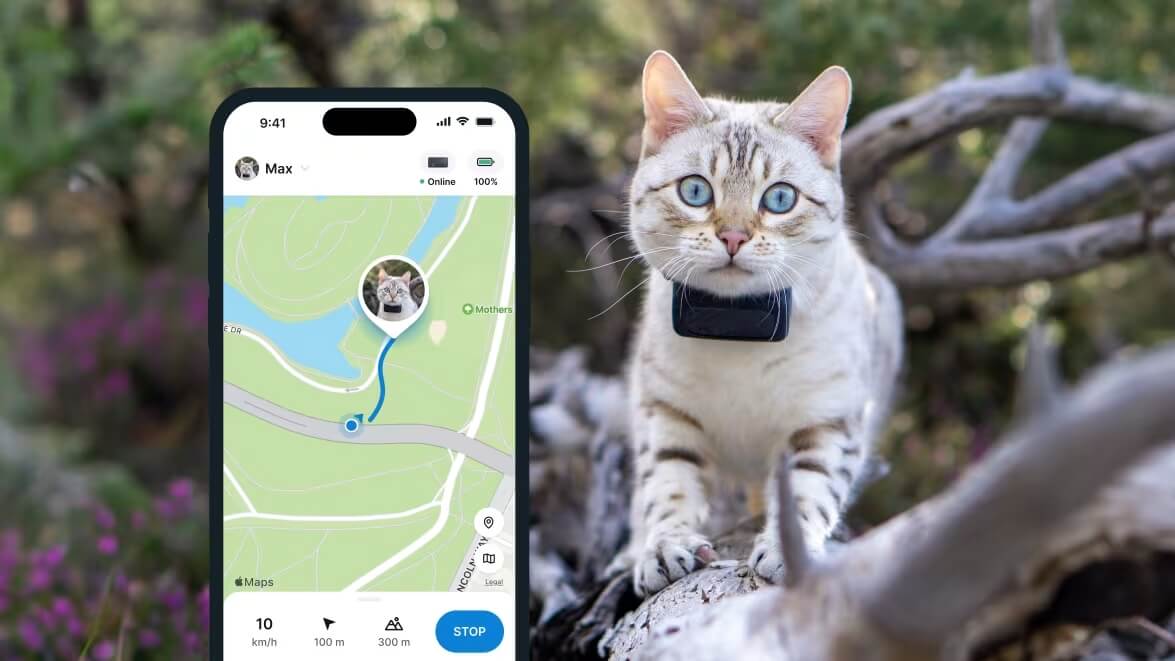Cat Hunting Behavior: Why Does My Cat Hunt?
Beneath your cat’s cute and cuddly exterior lurks a skilled and powerful hunter. But did you know that cat hunting behavior is also a key reason they get lost?
All cats are natural hunters and rely on built-in instincts to capture and kill prey. Yes, even Mr. Muffykins purring on your lap right now. But if you’ve ever found yourself baffled by cat hunting behavior or wondering – why does my cat hunt? I just fed them! – we’ve got you covered. Here’s everything you need to know about your feline buddy’s instincts, how to tame it, and how to keep tabs on their every move to ensure they aren’t off hunting somewhere dangerous.

Find out where your cat spends their time.
Read more- Why do cats hunt?
- Cat hunting behavior: Stalking & pouncing
- Why does my cat hunt? I JUST fed them!
- Why does my cat bring animals or birds as a gift?
- Why do cats play with their prey?
- What are the health risks for cats that hunt?
- How can I stop my cat from hunting?
- Where a cat GPS tracker can be a lifesaver
Why do cats hunt?
Hunting behavior is hard-wired into your cat’s DNA. In fact, it’s your cat’s wild ancestors that developed their hunting skills over millions of years of stalking and chasing prey to feed themselves and their young. Plus, to be fair, us humans have used cats to kill mice and other pests that ate farmers’ stored grain. (Like in ancient Egypt.)
Sadly, cat hunting behavior is a key reason yours might end up sneaking out and wandering away a bit too far from home. Or running into an endless amount of dangers outdoors – not least from other cats!
💡In these cases, a GPS tracker can be a potential lifesaver, especially if you’ve got a particularly adventurous cat. With just a glance at your phone, you’ll be able to track their every step in real-time. Or even learn their usual territory, so you know where to look first if they go missing.

Track your cat wherever they go
Get real-time location information, wherever they go. Find out when they go somewhere they shouldn’t, with Virtual Fences. And discover their favorite spots with Territory.
Cat hunting behavior: Stalking & pouncing
Picture a leopardess crouched on the African savannah. Every muscle is tensed, and she is laser-focused on an antelope grazing nearby. With a wriggle of her hindquarters, the leopard springs forward. After a brief high-speed chase, she brings down her prey with a powerful swat of her front paw and delivers a killing bite to the antelope’s throat.
Your cat is a scaled-down version of that African leopard. Their prey is not a large antelope, obviously, but something more appropriately sized like a songbird or mouse. But your pet cat’s hunting technique is very similar to that of a lion, leopard, bobcat, or mountain lion.
Many felines use the “stalk and pounce” technique to hunt their prey. These cats locate their prey, then crouch low to the ground and slowly creep toward their prey. When the cat is within striking distance, they’ll spring forward onto the prey. Other cats prefer to ambush their prey. They’ll hide, wait patiently for the right moment, and leap onto their prey.
In both cases, the prey is killed with a bite to the throat. The cat’s sharp canine teeth pierce the spinal cord and the powerful jaw crushes the windpipe.
Why does my cat hunt? I JUST fed them!
Domestic cats haven’t been selectively bred as much as dogs have. Hunting comes as naturally to a cat as eating and sleeping. So the urge to hunt isn’t tied to hunger. In the wild, cats hunt all the time, even if they are not hungry, because they never know when their next meal will come. If a cat waited until they were desperately hungry to hunt, they might be too weak to capture prey. Your little furball may not need wild prey for survival, but their hunting instincts are powerful. So your cat may hunt even if you provide easy access to nutritious food.
Why does my cat bring animals or birds as a gift?
This may be a sign that your cat considers you a part of their family. They’re sharing the bounty of their hunt, just as Mama Cat may have done with them when they were kittens. Because, in general, your cat actually sees you as a bigger, clumsier cat! So if you’re finding your feline friend bringing you their “gifts”, it’s actually their way of “teaching” you how to hunt.
Indoor cats hunt, too, but their prey is toy mice or balls, which your cat may deliver to you as a gift, even though the toys can’t be eaten. Letting them outdoors for some supervised playtime can help them develop their hunting instincts better.
Why do cats play with their prey?
When a cat bats around its prey after the initial pounce, it may seem like they want to “play” with their catch. But in reality, the cat is tiring out the animal until it’s safe to go in for the killing bite. And when you think about the animals your cat might usually prey on, this makes a lot of sense. Mice and rats have sharp incisor teeth that can bite and injure your cat. Birds’ beaks are pointy and can cause damage, too.
What are the health risks for cats that hunt?
Cats are born hunters, but allowing your cat to capture prey outdoors exposes them to risks. Not only can your cat be injured by a rodent’s sharp teeth during a capture, they can also become ill by eating their wild prey. Like, for example from parasites, that may end up in their intestines – from mice, rats, and songbirds. Which can cause diarrhea and vomiting and also infect other pets and humans.
- Toxoplasmosis is a common parasite in outdoor cats. They may ingest the cysts (eggs) of this parasite by eating infected mice or rats, or by coming into contact with infected feces or soil. The toxoplasmosis parasite completes its life cycle in cats.
- Cats infected with toxoplasmosis may never show any symptoms, but they can pass the parasite on to humans who handle their cat litter and accidentally ingest the microscopic cysts. Pregnant women can suffer serious complications if they become infected with toxoplasmosis parasites.
- Other diseases like the plague, leptospirosis and hantavirus are transmitted by rodents, either to cats or directly to humans if the rodent is brought into the home by your cat.
❤️🩹 To be safe, wear disposable gloves when handling any prey that your cat brings home, and dispose of the dead animal safely. If possible, prevent your cat from eating the prey. Always wash your hands thoroughly with soap and water after cleaning your cat’s litter box.
Also be sure to have regular fecal testing done on your outdoor cat to detect any intestinal parasites. Your veterinarian can recommend treatment. Consider flea and tick prevention measures as well, if your cat spends any time outdoors.
How can I stop my cat from hunting?
Cats hunting and bringing home prey can be unpleasant for you, and it’s also becoming a subject of increasing concern; studies are being done on just how exactly domestic cats impact local wildlife.1 To stop your cat from hunting, we recommend you:
- Keep your cat indoors – but occupied, with a ton of scratching toys to redirect any hunting behaviors.
- Create a safe outdoor space for your cat, like a heated cat house or a catio.
- Play with your cat plenty throughout the day, especially around mornings and evenings. A tired cat may be less motivated to go out hunting.
- Use toys that resemble “prey” like toy mice or feather wands that resemble birds.
- Make sure your cat’s diet has enough meat and offer small meals throughout the day to keep them full. Try hiding food in different parts of your home to encourage your cat to “hunt” it out. Else, try puzzle feeders to challenge your cat as they “work” to get their food.
- Keep your cat inside at high prey activity times, meaning dawn and dusk.
Try these playtime ideas to redirect your cat’s hunting behaviors
- Paper bag: Open a large paper bag on the floor. Pretend you are a mouse and scratch your fingers along the back of the bag. Watch your cat zero in on the scratching sound, wiggle their hindquarters, and pounce into the bag. Take care that your fingers don’t receive the killing bite!
- Wand or fishing pole: Tie a ribbon or string to the end of the pole or wand. Stand around the corner of a wall where your cat can’t see you. Toss the line around the corner toward your cat. Let it sit for a minute, then pull the line just an inch or two toward you. Kitty will become very interested and crouch low, preparing to stalk the “prey.” Pull the line again, just a few inches. Prepare for attack!
- Disappearing string: Lay a string on the floor and cover most of it with a small rug, allowing a few inches to be exposed near your cat. Pull the string slowly, so it “disappears” under the rug. Watch kitty go wild looking for the hidden string!
Where a cat GPS tracker can be a lifesaver
Finally, a cat GPS tracker from Tractive can help you keep a closer eye on your furry friend if they roam outside. After all, cat hunting behavior is one of the reasons why cats run away from home – or just wander off far enough to get lost, stuck, or injured mid-hunt. But with one strapped to your cat’s collar, you can track them:
- In real-time,
- Over an unlimited range,
- Across a Heat Map of their favorite “hunting” spots,
- And even while on vacation (or 175 countries on a Premium subscription)

All with just a glance at your phone.
😺 “We love seeing exactly what Zoe gets up to at night when she’s out hunting. My favourite feature of Tractive is the Safe Zone. We live on a busy road so it gives me peace of mind knowing I get an alert as soon as Zoe has left the property so I can go and find her and bring her home safe.”
– Mary, NZ (Source: Trustpilot)



